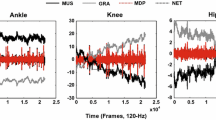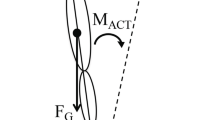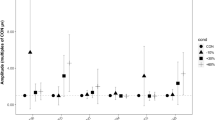Abstract
The aim of this study was to investigate the postural center of pressure (COP) and surface muscle (EMG) dynamics of young adult participants under conditions where they were required to voluntarily produce random and regular sway motions in contrast to that of standing still. Frequency, amplitude and regularity measures of the COP excursion and EMG activity were assessed, as were measures of the coupling relations between the COP and EMG outputs. The results demonstrated that, even when standing still, there was a high degree of regularity in the COP output, with little difference in the modal frequency dynamics between standing still and preferred motion. Only during random conditions was a significantly greater degree of irregularity observed in the COP measures. The random-like movements were also characterized by a decrease in the level of synchrony between COP motion on the anterior–posterior (AP) and medio-lateral (ML) axes. In contrast, at muscle level, the random task resulted in the highest level of regularity (decreased ApEn) for the EMG output for soleus and tibialis anterior. The ability of individuals to produce a random motion was achieved through the decoupling of the COP motion in each dimension. This decoupling strategy was reflected by increased regularity of the EMG output as opposed to any significant change in the synchrony in the firing patterns of the muscles examined. Increased regularity across the individual muscles was accompanied by increased irregularity in COP dynamics, which can be characterized as a complexity tradeoff. Collectively, these findings support the view that the dynamics of muscle firing patterns does not necessarily map directly to the dynamics at the movement task level and vice versa.







Similar content being viewed by others
Notes
Although the term complexity holds different meanings in various contexts, for the purposes of this experiment, we have operationally defined complexity as the unpredictability of sequences within a time-series.
References
Abasolo D, Hornero R, Espino P, Poza J, Sanchez CI, de la Rosa R (2005) Analysis of regularity in the EEG background activity of Alzheimer’s disease patients with Approximate Entropy. Clin Neurophysiol 116:1826–1834
Balasubramaniam R, Riley MA, Turvey MT (2000) Specificity of postural sway to the demands of a precision task. Gait Posture 11:12–24
Bar-Yam Y (2004) Multiscale complexity/entropy. Adv Complex Syst 7:47–63
Bassingthwaighte JB, Liebovitch LS, West BJ (1994) Fractal physiology. Oxford University Press, New York
Beckers F, Verheyden B, Aubert AE (2006) Aging and nonlinear heart rate control in a healthy population. Am J Physiol Heart Circ Physiol 290:H2560–H2570
Burioka N, Miyata M, Cornelissen G, Halberg F, Takeshima T, Kaplan DT, Suyama H, Endo M, Maegaki Y, Nomura T et al (2005) Approximate entropy in the electroencephalogram during wake and sleep. Clin EEG Neurosci 36:21–24
Collins JJ, De Luca CJ (1995) The effects of visual input on open-loop and closed-loop postural control mechanisms. Exp Brain Res 103:151–163
Deutsch KM, Newell KM (2004) Intra-limb segmental influences on random-like movements in humans. Neurosci Lett 367:218–223
Edwards AS (1946) Body sway and vision. J Exp Psychol 36:526–535
Elble RJ (2000) Origins of tremor. Lancet 355:1113–1114
Elble RJ, Koller WC (1990) Tremor. Johns Hopkins, Baltimore
Freund H-J, Hefter H (1993) The role of the basal ganglia in rhythmic movement. In: Narabayashi H, Nagatsu T, Yanagisawa N, Mizuno Y (eds) Advances in neurology. Raven Press, New York, vol 60, pp 88–92
Gatev P, Thomas S, Kepple T, Hallett M (1999) Feedforward ankle strategy of balance during quiet stance in adults. J Physiol 514(Pt 3):915–928
Halliday AM, Rosenberg JR, Amjad AM, Breeze P, Conway BA, Farmer SF (1995) A framework for the analysis of mixed time series/point process data—theory and application to the study of physiological tremor, single motor unit discharges and electromyograms. Prog Biophys Mol Biol 64:237–278
Kavanagh JJ, Barrett RS, Morrison S (2005a) Age-related differences in head and trunk coordination during walking. Hum Mov Sci 24:574–587
Kavanagh JJ, Morrison S, Barrett RS (2005b) Coordination of head and trunk accelerations during walking. Eur J Appl Physiol 94:468–475
Kovacs N, Balas I, Illes Z, Kellenyi L, Doczi TP, Czopf J, Poto L, Nagy F (2006) Uniform qualitative electrophysiological changes in postoperative rest tremor. Mov Disord 21:318–324
Kugler PN, Turvey MT (1987) Information, natural law, and the self-assembly of rhythmic movement. Erlbaum, Hillsdale
Masani K, Vette AH, Popovic MR (2006) Controlling balance during quiet standing: proportional and derivative controller generates preceding motor command to body sway position observed in experiments. Gait Posture 23:164–172
McAuley J, Rothwell J, Marsden C (1997) Frequency peaks of tremor, muscle vibration and electromyographic activity at 10 Hz, 20 Hz and 40 Hz during human finger muscle contraction may reflect rhythmicities of central neural firing. Exp Brain Res 114:525–541
Mitra S, Amazeen PG, Turvey MT (1998) Intermediate motor learning as decreasing active (dynamical) degrees of freedom. Hum Mov Sci 17:17–65
Mochizuki G, Ivanova TD, Garland SJ (2005) Synchronization of motor units in human soleus muscle during standing postural tasks. J Neurophysiol 94:62–69
Morrison S, Newell K (1996) Inter- and intra-limb coordination in arm tremor. Exp Brain Res 110:455–464
Morrison S, Newell K (1999) Bilateral organization of physiological tremor in the upper limb. Eur J Appl Physiol Occup Physiol 80:564–574
Myers LJ, Lowery M, O’Malley M, Vaughan CL, Heneghan C, St Clair Gibson A, Harley YXR, Sreenivasan R (2003) Rectification and non-linear pre-processing of EMG signals for cortico-muscular analysis. J Neurosci Methods 124:157–165
Natarajan K, Acharya UR, Alias F, Tiboleng T, Puthusserypady SK (2004) Nonlinear analysis of EEG signals at different mental states. Biomed Eng Online 3:7–7
Neuringer A (2004) Reinforced variability in animals and people: implications for adaptive action. Am Psychol 59:891–906
Newell KM, Bodfish JW (2006) Dynamical origins of stereotypy: Relation of postural movements during sitting to stereotyped movements during body rocking. Am J Ment Retard (in press)
Newell KM, Slifkin AB (1998) The nature of movement variability. In: Piek JJ (ed) Motor behavior and human skill. Human Kinetics, Champaign
Newell KM, Vaillancourt DE (2001) Dimensional change in motor learning. Hum Mov Sci 20:695–715
Newell KM, Slobounov SM, Slobounova BS, Molenaar PCM (1997a) Short-term non-stationarity and the development of postural control. Gait Posture 6:56–62
Newell KM, Slobounov SM, Slobounova BS, Molenaar PCM (1997b) Stochastic processes in postural center-of-pressure profiles. Exp Brain Res 113:158–164
Newell KM, Challis S, Morrison S (2000a) Dimensional constraints on limb movements. Hum Mov Sci 19:175–201
Newell KM, Deutsch KM, Morrison S (2000b) On learning to move randomly. J Motor Behav 32:314–320
Newell KM, Vaillancourt DE, Sosnoff JJ (2006) Aging, complexity, and motor performance. In: Handbook of the psychology of aging. Academic Press, London, pp 163–182
Pincus SM (1991) Approximate entropy as a measure of system complexity. Proc Natl Acad Sci USA 88:2297–2301
Pincus SM (1994) Greater signal regularity may indicate increased system isolation. Math Biosci 122:161–181
Pincus SM (2000) Irregularity and asynchrony in biologic network signals. Methods Enzymol 321:149–182
Pincus S, Singer BH (1996) Randomness and degrees of irregularity. Proc Natl Acad Sci USA 93:2083–2088
Pincus SM, Cummins TR, Haddad GG (1993) Heart rate control in normal and aborted-SIDS infants. Am J Physiol 264:R638–R646
Randall JM, Matthews RT, Stiles MA (1997) Resonant frequencies of standing humans. Ergonomics 40:879–886
Riley MA, Balasubramaniam R, Turvey MT (1999) Recurrence quantification analysis of postural fluctuations. Gait Posture 9:65–78
Sturman MM, Vaillancourt DE, Corcos DM (2005) Effects of aging on the regularity of physiological tremor. J Neurophysiol 93:3064–3074
Vaillancourt DE, Newell KM (2000) Amplitude changes in the 8–12, 20–25, and 40 Hz oscillations in finger tremor. Clin Neurophysiol 111:1792–1801
Winter D (1995) Balance and posture during quiet standing. In: Winter D (ed) A.B.C. of balance during standing and walking. Waterloo Biomechanics, Waterloo
Winter DA (1990) Motor control and biomechanics of human movement. Wiley, New York
Winter DA, Prince F, Frank JS, Powell C, Zabjeck KF (1996) Unified theory regarding A/P and M/L balance in quiet stance. J Neurophysiol 75:2334–2343
Yates FE (1987) Self-organizing systems: the emergence of order. Plenum Press, New York
Author information
Authors and Affiliations
Corresponding author
Rights and permissions
About this article
Cite this article
Morrison, S., Hong, S.L. & Newell, K.M. Inverse relations in the patterns of muscle and center of pressure dynamics during standing still and movement postures. Exp Brain Res 181, 347–358 (2007). https://doi.org/10.1007/s00221-007-0928-x
Received:
Accepted:
Published:
Issue Date:
DOI: https://doi.org/10.1007/s00221-007-0928-x




